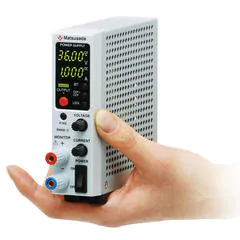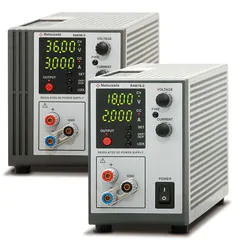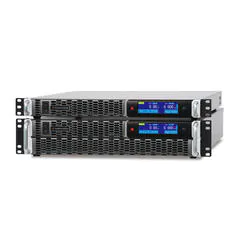The Basic of Analog Remote Control
What is most important thing about remote control of DC power supplies is to ensure the proper connection for installation as well as safe grounding that can achieve high performance, high stability, and low ripple with the device.
Remote Control
| Remote/Local switching | This signal switches between remote control and local control. |
|---|---|
| External Output ON/OFF (Previous: Remote switch (LS)) |
Connect a relay or switch to control output ON/OFF. |
| Interlock (Not safety interlock) (Previous: Door switch (LD)) |
Connect the terminal to a switch on a door or protective cover, and when that contact opens, the output stops. (This is not a safety interlock as defined by the machinery directive.) |
| External Inhibit (INH) | Enables/disables the output. |
Programming
Output voltage, current, etc. can be controlled by an external analog remote. There are two methods for analog programming of output and protection value.
- External control by adjustable voltage source <example> 0 to 10 V
- External control by potentiometer or variable resister <example> 0 to 10 kΩ
| Output voltage | Analog programming of output voltage. |
|---|---|
| Output current | Analog programming of output current. |
| Output power | Analog programming of output power. |
| Overvoltage protection (OVP) | Analog programming of overvoltage protection value. Turns off the output and protects the load in the event of an error due to overvoltage. |
| Overcurrent protection (OCP) | Analog programming of overcurrent protection value. Turns off the output and protects the load in the event of an abnormality due to overcurrent such as a short circuit. |
| Overpower protection (OPP) | Analog programming of overpower protection value. Turns off the output and protects the load in the event of an error due to overpower. |
Monitoring
| Voltage monitor | Output voltage can be monitored and measured by connecting a multimeter or other voltmeter. For example, the monitor voltage of 0 to 10 V can be checked corresponding to the zero to full scale of the output voltage. |
|---|---|
| Current monitor | Output current can be monitored and measured by connecting a multimeter or other voltmeter. For example, the monitor voltage of 0 to 10 V can be checked corresponding to the zero to full scale of the output current. |
Remote sense
| Voltage remote sensing | The voltage drop for the resistance due to the output cable can be compensated by connecting the remote sensing line to both poles of the load. |
|---|
Status
The various statuses can be monitored by connecting a multimeter to the corresponding pins to monitor the status of the instrument.
| OUTPUT | Output ON state signal |
|---|---|
| Constant Voltage (CV) | Constant Voltage (CV) state signal |
| Constant Current (CC) | Constant Current (CC) state signal |
| Constant Power (CP) | Constant Power (CP) state signal |
| Constant Resistance (CR) | Constant Resistance (CR) state signal |
| Fault (FLT) | Various fault signals Faults that can be detected vary by products. Fault signals include overvoltage protection, overcurrent protection, overpower protection, overtemperature protection, low AC input voltage, sense reverse connection, and interlock. |
| Overvoltage protection (OVP) | Overvoltage Protection (OVP) state signal |
| Overcurrent protection (OCP) | Overcurrent Protection (OCP) state signal |
| Overpower Protection (OPP) state signal | Overpower Protection (OPP) state signal |
| Overtemperature protection (OTP) | Overtemperature Protection (OTP) state signal |
| AC input failure (ACF) | AC Input Failure (ACF), low input voltage state signal |
| Remote sense reverse connection failure | Remote sense reverse connection failure state signal |
| Interlock (previous: Door switch OFF) | Interlock state signal (previous: Door switch OFF) |
Terms
| Master/Slave | Master/slave is a function that allows the slave device to follow the operation of the master device. When the master device is controlled, the slave device follows and performs the same operation. By connecting the output terminals of the power supply in series or parallel, it can be controlled as a single power supply with increased voltage and current outputs. |
|---|---|
| 1 mA current source | The 1 mA current source is a precision constant current source to control the set value of the output in resistance mode. |
| Reference voltage | There are two types of reference voltages: internal and external. The internal reference voltage is output from the analog remote terminal, and the output can be controlled by connecting an external resistor. The other external reference voltage provides another reference power supply, and its output is input to the analog remote terminal to control the power supply output. |
| Fail-safe mode | Fail-safe mode is a mode in which the logic of the control is inverted to ensure safety even in the event of a control wiring malfunction such as wire breakage. |
| Common (COM) | Common is a shared connection point, which is a potential that serves as a signal reference. Or, it is the common ground. |
| Retern (RTN) | Return refers to the return destination of a signal output. It is used to describe the terminal to which the output returns through the circuit to which it is connected. |
| Relay | A relay is an electromagnetic relay, which is connected to a device to transmit a signal. |
| TTL | TTL stands for transistor transistor level and represents a signal standard. |
| Open collector | Open collector represents the signal output method of an electronic circuit. The collector of the transistor is the output terminal. |
| Variable resistor | A potentiometer is a type of variable resistance that can be changed to any resistance value. It is used in variable resistors for analog remote control because the resistance value can be set finely. It is also called a volume potentiometer or pot. |
| Output state autorecovery prevention (Previous: power failure protection) | The Output state auto-recovery prevention is a safety function that prevents output when the power supply is in an output state and the input power supply is cut off due to a power failure or the like and then returns. |
Appendix
Waveform Conversion Table
- [Note]
-
- Peak factor = RMS value/Mean value
- Crest factor = Maximum value/RMS value
| Name | Wave | Shape | RMS | Crest factor | Peak factor |
|---|---|---|---|---|---|
| Sine wave |

|

|

|

|

|
| Half-wave rectifier wave |

|

|

|
2 |

|
| Full-wave rectifier wave |

|

|

|

|

|
| Triangular wave |

|

|

|

|

|
| Rectangular wave |

|
A | A | 1 | 1 |
| Square wave |

|

|

|

|

|
Wire Gauge Index
| Gauge A.W.G |
Diameter [inches] |
Diameter [mm] |
Cross-sectional area [mm2] |
|---|---|---|---|
| 0000 | 0.4600 | 11.6840 | 107 |
| 000 | 0.4096 | 10.4038 | 85.0 |
| 00 | 0.3648 | 9.2659 | 67.4 |
| 0 | 0.3249 | 8.2525 | 53.5 |
| 1 | 0.2893 | 7.3482 | 42.4 |
| 2 | 0.2576 | 6.5430 | 33.6 |
| 3 | 0.2294 | 5.8268 | 26.7 |
| 4 | 0.2043 | 5.1892 | 21.1 |
| 5 | 0.1819 | 4.6203 | 16.8 |
| 6 | 0.1620 | 4.1148 | 13.3 |
| 7 | 0.1443 | 3.6652 | 10.6 |
| 8 | 0.1285 | 3.2639 | 8.37 |
| 9 | 0.1144 | 2.9058 | 6.63 |
| 10 | 0.1019 | 2.5883 | 5.26 |
| 11 | 0.0907 | 2.3038 | 4.17 |
| 12 | 0.0808 | 2.0523 | 3.31 |
| 13 | 0.0720 | 1.8288 | 2.63 |
| 14 | 0.0641 | 1.6281 | 2.08 |
| 15 | 0.0571 | 1.4503 | 1.65 |
| 16 | 0.0508 | 1.2903 | 1.31 |
| 17 | 0.0453 | 1.1506 | 1.04 |
| 18 | 0.0403 | 1.0236 | 0.823 |
| Gauge A.W.G |
Diameter [inches] |
Diameter [mm] |
Cross-sectional area [mm2] |
|---|---|---|---|
| 19 | 0.0359 | 0.9119 | 0.653 |
| 20 | 0.0320 | 0.8128 | 0.519 |
| 21 | 0.0285 | 0.7239 | 0.412 |
| 22 | 0.0253 | 0.6426 | 0.325 |
| 23 | 0.0226 | 0.5740 | 0.259 |
| 24 | 0.0201 | 0.5105 | 0.205 |
| 25 | 0.0179 | 0.4547 | 0.162 |
| 26 | 0.0159 | 0.4039 | 0.128 |
| 27 | 0.0142 | 0.3607 | 0.102 |
| 28 | 0.0126 | 0.3200 | 0.08 |
| 29 | 0.0113 | 0.2870 | 0.0647 |
| 30 | 0.0100 | 0.2540 | 0.0507 |
| 31 | 0.0089 | 0.2261 | 0.0401 |
| 32 | 0.0080 | 0.2032 | 0.0324 |
| 33 | 0.0071 | 0.1803 | 0.0255 |
| 34 | 0.0063 | 0.1600 | 0.0201 |
| 35 | 0.0056 | 0.1422 | 0.0159 |
| 36 | 0.0050 | 0.1270 | 0.0127 |
| 37 | 0.0044 | 0.1143 | 0.0103 |
| 38 | 0.0040 | 0.1016 | 0.00811 |
| 39 | 0.0035 | 0.0889 | 0.00621 |
| 40 | 0.0031 | 0.0787 | 0.00487 |
Related Technical Articles
Recommended products
Matsusada Precision's high-performance DC power supplies







